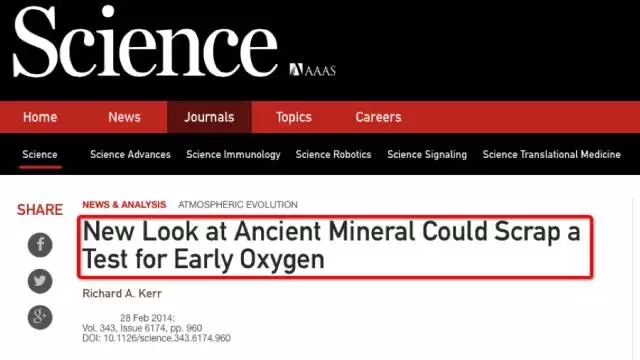2016年12月3日亚太SAT阅读真题回忆Passage5
2016年12月3日SAT考试已经结束。新航道SAT培训时间与你分享12月3日的SAT考情。本篇文章分享的是:2016年12月3日亚太SAT阅读真题回忆第五篇-New Look at Ancient Mineral Could Scrap a Test for Early Oxygen,也是最后一篇阅读真题。我们一起来看一下吧!
第五篇
题材:科学

New Look at Ancient Mineral Could Scrap a Test for Early Oxygen
梗概
最后一篇文章选自《科学》杂志,发表于2014年2月28日。文章主要是对早期氧气出现时间的研究提出了质疑,认为氧气出现的时间可能要晚于之前研究所提出的时间。
原文
Geologists trying to sniff out signs of oxygen in Earth’s early air have long struggled with a major obstacle: eons-oldrocks that provide only a ragged, fragmentary record of the gas. Even so, somehave for decades taken the presence of the mineral hematite in a so-calledbanded iron formation (BIF) in northwestern Australia as a sign that 2.5billion years ago, Earth’s atmosphere had at least a trace(考察该词汇的语境含义)of oxygen. The ruddy mineral was thought to record the moment whenphotosynthesis first pushed oxygen to levels high enough to fully oxidize iron.
Now,a new study of that BIF, using the latest analytical techniques, suggests thatthis rock record has been misread. If true, oxygen actually may have appearedin the atmosphere hundreds of millions of years later than this BIFsuggested. Geologists say the study raises serious questions about a supposedlyreliable test. “People are recognizing that we have to be more careful,” says geochemist Timothy Lyons ofthe University of California, Riverside. “We need to increasingly focus ondoing just what [these authors] did, a more careful characterization of samples.”(通过该句考察询证的对应)
In apaper in the Geological Society of America Bulletin published online on3 February, geologists Birger Rasmussen, Bryan Krapež, and Daniela Meier ofCurtin University, Bentley, Australia, reanalyze the mineral makeup of theDales Gorge BIF, an ancient ocean bottom now in western Australia. Theiroriginal intent was to explain how run-of-the-mill BIFs like Dales Gorge turn into the iron-rich ores(考察该句中turn into后的细节)so heavily minedworldwide.
Theteam took 400 translucent slivers of Dales Gorge rock from four deep-drillcores and studied them with several kinds of modern optical microscopes, aswell as with a scanning electron microscope equipped with an x-ray spectrometerfor elemental analysis. That let the researchers see where each microscopicmineral in the rock formed and get a sense of the order of their creation.Knowing the conditions under which each mineral could form, the researcherscould tell a tale about conditions in the ocean beneath which the BIF was firstlaid down—a time when oxygen gas may have been making its first, tentativeappearance on Earth.
Theirmore detailed look at the rocks focused on hematite, which consists of ironcombined with as much oxygen as iron’s bonds can hold. Because the Dales GorgeBIF has plenty of oxygen-rich hematite, earlier researchers concluded thatoxygen gas from the atmosphere must have already been dissolved in the oceanand in the underlying sediments 2.5 billion years ago, when the makings of thisBIF first settled to the ocean bottom.
Butthe Australian researchers see signs that the BIF’s hematite was aJohnny-come-lately. Otheriron-rich minerals(该句中对other iron的描述是研究者产生疑问的本源,重点考察)—onesthat, unlike hematite, form in the absence of oxygen gas—were there in theoriginal seafloor sediments, the group argues. But they conclude that this ironwas probably not oxidized, producing the hematite, until about 300 millionyears later, after tectonicforces(细节题考察)crumpledthe sea floor into mountains and drove oxygen-laden water down into the rock.Given that western Australia hosts the archetypal examples of BIFs in thatearly time, Rasmussen says, the Dales Gorge formation “probably records fundamentalprocesses that also affected other BIFs at some time in their history.”
Othersare not ready to go quite that far. BIF geologist Bruce Simonson of OberlinCollege in Ohio praises the team’s “careful study and reasonable conclusions”but adds that “it would bepremature to extrapolate their conclusions to all BIFs everywhere.”(考察该句中对本文中理论的批判,考察该句的同义改写)Even so, both he and Lyons see the new work as a warning shot. “Big stories [ofoxygen’s history] have been told by small amounts of data,” Lyons says. Lately,“by being more careful, we’re seeing a more nuanced, more coherent picture.”
SAT真题下载:
更多真题下载,请:SAT真题下载








